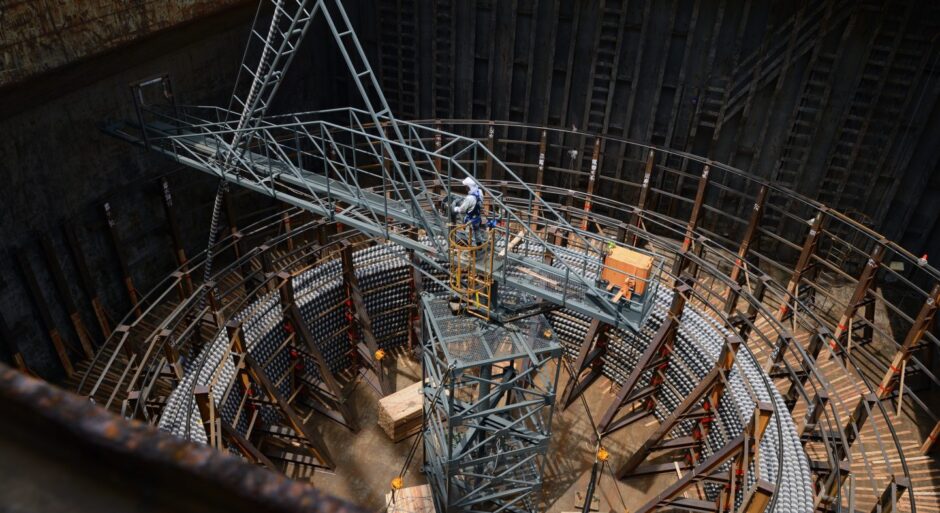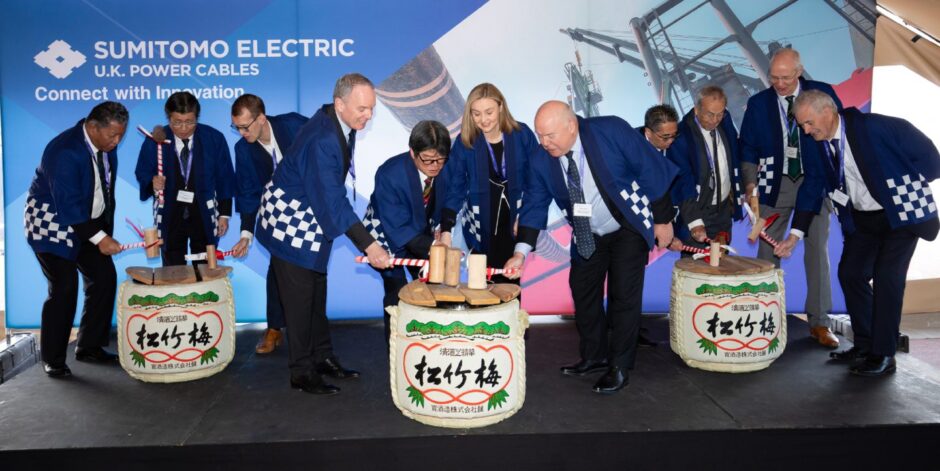
Japanese firm Sumitomo Electric held a ground breaking ceremony for its £350 million subsea cable factory on the Cromarty Firth after it was named as a “preferred bidder” for a contract with SSE.
SSE Transmission has struck a preliminary agreement with Sumitomo Electric Industries and its subsea cable installation partner Van Oord Offshore Wind to build a new subsea cable connecting Shetland to the mainland grid.
Sumitomo Electric Group President Osamu Inoue hosted a tea ceremony celebrating the start of construction of the facility, the firm expects will be producing high voltage direct current (HVDC) cable from the third quarter of 2026.
The Japanese firm has estimated it will provide up to 150 jobs at Nigg.
SSE said that negotiations on the deal would continue and until “contract award status” was granted later this year. It also said it was awaiting confirmation of a regulatory framework for its investment from Ofgem.
Shetland cable deal anchors factory in Nigg
Sumitomo Electric UK vice president Michael Englebrecht said the agreement represented the “final part of the puzzle” to “have a commercial order in place” which means they are now “pushing ahead” with the investment in the factory.
Sumitomo has established offices in Glasgow and Inverness.
Englebrecht said the firm aims to recruit “local and expand from there”, and any skills gaps would be delivered by training.
He said: “If we can’t find the necessary skills in the area what we would do is look to train up by sending people over to Japan and then bringing them back with the skills to make high voltage cable.”
The factory will largely supply UK demand for HVDC subsea cable. More widely there are concerns that as offshore wind development takes place particularly in deeper water, the global market faces possible shortages of cables.
“There is no doubt in our minds there will be pressure on the supply chain and we will be looking to fill that gap,” Englebrecht said.
Connecting offshore wind to the grid
National Grid Electricity System Operator (ESO) confirmed the need for a second subsea cable from Shetland in its strategic network plan published in March. This will connect offshore wind farms proposed off Shetland and add 2GW of renewable energy to the grid.
The first subsea HVDV power cable connecting Shetland to the mainland was completed last year.
The cable factory project has been backed with £24.5m of public sector funding.
Representatives from the UK and Scottish Governments joined in the celebration of start of work on the new facility.
Investment in supply chain
Inoue said he “sincerely appreciate SSEN Transmission’s decision to select us as the preferred bidder of Shetland 2 project to enable our significant investment here in the UK”.
He added: “Transmission cables are key essential infrastructures to make so called energy transition to renewables into reality.
“I believe, this factory will make good contributions towards establishment of local supply chains and to realise UK and Scottish Governments’ net zero initiatives.”
Rob McDonald, Managing Director of SSEN Transmission, said: “Sumitomo’s investment in a new cable manufacturing facility in Nigg will help deliver a homegrown supply chain to help support our energy security and net zero infrastructure requirements.
“This is great news for the Highland economy and will support hundreds of skilled jobs in the region, helping unleash the economic potential the clean energy transition presents for the north of Scotland.”
Màiri McAllan, Scottish Cabinet Secretary for Net Zero and Energy, highlighted the facility will be Sumitomo’s first cable factory in Europe and the first HVDC cable factory in the UK.
Another is being built by XLCC in Ayr on the site of the Hunterston B nuclear plant which is currently being decommissioned.
She said: “The fast-growing offshore wind industry offers significant opportunities to attract inward investment and unlock wider economic benefits, not least in our transformational Green Freeports.
“That is why we providing up to £500m to anchor the offshore wind supply-chain in Scotland to ensure our workforce, businesses and communities all benefit from the offshore renewables revolution.”
Recommended for you


 © Simon Price PA Media Assignments
© Simon Price PA Media Assignments © Simon Price PA Media Assignments
© Simon Price PA Media Assignments © Simon Price PA Media Assignments
© Simon Price PA Media Assignments